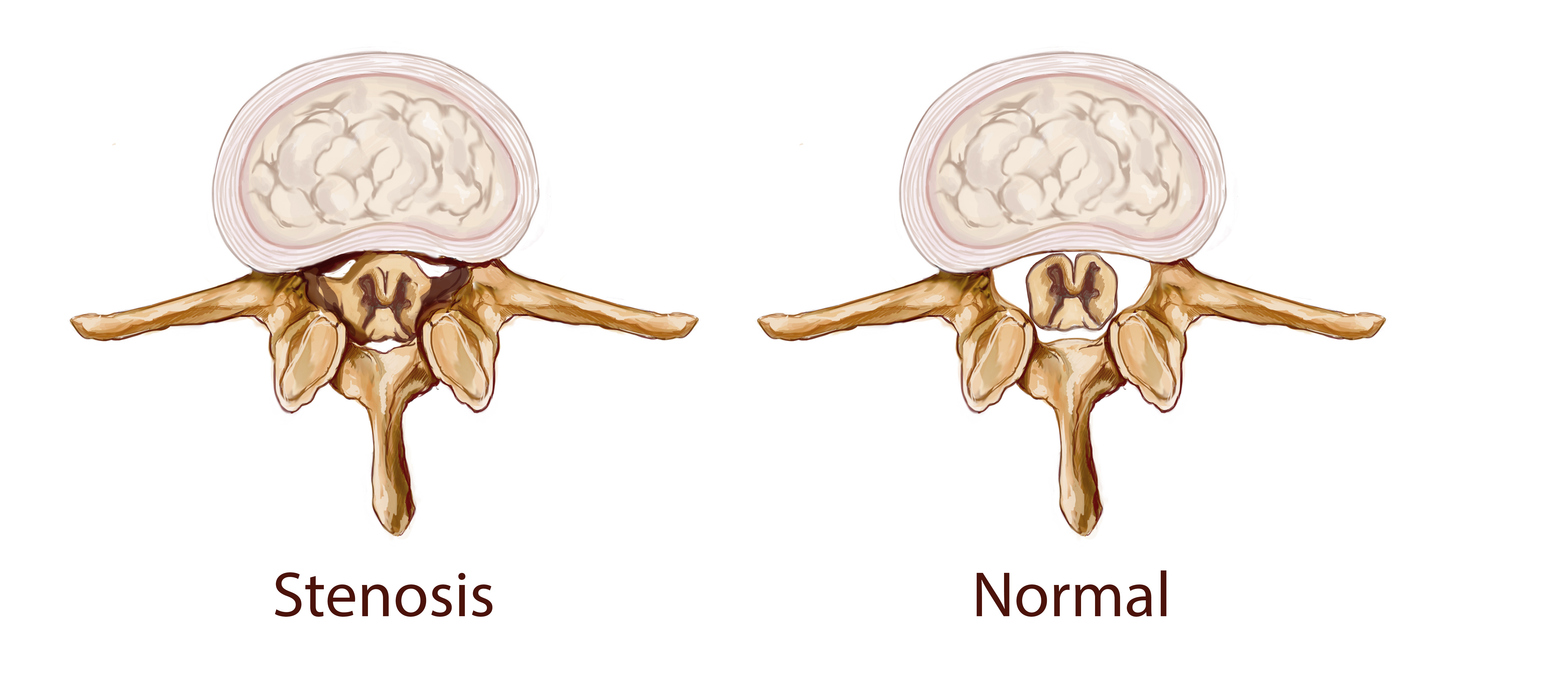Laurie's Blogs.
Apr 2024
Let’s Talk Spinal Stenosis in Dogs!

Spinal stenosis is narrowing of the spinal column that causes pressure on the spinal cord, or narrowing of the openings (called neural foramina) where spinal nerves leave the spinal column.
Introduction:
Spinal stenosis is a debilitating condition that can affect dogs, leading to pain, weakness, and mobility issues. This narrowing of the spinal canal can compress the spinal cord and nerves, causing a range of symptoms. In this blog post, we'll explore the demographics, etiology, signs and symptoms, treatment options, and prognosis of spinal stenosis in dogs.
Demographics:
Spinal stenosis can occur in dogs of any age, breed, or size, but certain factors may predispose some dogs to develop this condition. Large and giant breeds, such as German Shepherds, Doberman Pinschers, and Great Danes, are more commonly affected by degenerative spinal conditions that can lead to stenosis. Additionally, older dogs may be more prone to spinal stenosis due to age-related changes in the spine.
Etiology:
The etiology of spinal stenosis in dogs can be multifactorial, but it often involves degenerative changes in the spine, such as:
- Degenerative Changes: Degeneration of the spine is one of the primary causes of spinal stenosis, leading to disc bulging, herniation, or collapse. Degenerative changes in the facet joints, ligaments, and bones of the spine can also occur, resulting in bone spurs (osteophytes) and thickening of ligaments, which contribute to narrowing of the spinal canal.
- Herniated Discs: A past or present herniated disc can compress the spinal cord or nerve roots, leading to symptoms of spinal stenosis.
- Congenital Malformations: Some dogs may be born with abnormalities in the structure of their spine, predisposing them to spinal stenosis later in life. These abnormalities may include a narrow spinal canal, or malformed vertebrae.
- Trauma: Injuries to the spine, such as fractures or dislocations, can result in spinal cord compression and stenosis.
- Tumors: Tumors within or adjacent to the spinal canal can compress the spinal cord or nerve roots, leading to spinal stenosis. These tumors may be primary (originating from spinal tissue) or secondary (metastatic tumors spreading from other parts of the body).
Signs and Symptoms:
The signs and symptoms of spinal stenosis in dogs can vary depending on the location and severity of the narrowing. Common signs may include:
- Pain or discomfort, especially when touched or during movement.
- Difficulty walking or standing, particularly in the hind limbs. May begin to drag the feet or alter the swing of the limb.
- Weakness or paralysis in the limbs, which may progress over time.
- Loss of bladder or bowel control, indicating severe compression of the spinal cord or cauda equina.
- Reluctance to jump, run, or engage in physical activity.
- Changes in posture or gait, such as a hunched back or an abnormal "bunny hopping" gait.
In people, we also hear of the following symptoms:
- Numbness or tingling: People with spinal stenosis may experience numbness or tingling sensations in the affected area. This can manifest as a pins-and-needles sensation or a feeling of "electricity" running down the arms or legs. (A dog experiencing this sensation might carry its limb differently, make kick out a leg, or even stop to chew on a limb.)
- Pain relief with rest or bending forward: People with spinal stenosis often find that their symptoms improve when they rest or when they lean forward. This is because bending forward can temporarily increase the space within the spinal canal, relieving pressure on the nerves. (Dogs may tend to sit down and refuse to move on a walk… and to be honest, this whole blog is because THIS ONE piece of information should help a practitioner to include spinal stenosis in their list of differential diagnoses.)
Treatment Options:
Treatment for spinal stenosis in dogs aims to alleviate pain, improve mobility, and prevent further progression of the condition. Treatment options may include:
- Conservative Management: This may involve rest, pain medications, anti-inflammatory drugs, and physical therapy to reduce inflammation and strengthen supporting muscles.
- Surgery: Surgical intervention may be necessary to decompress the spinal cord and stabilize the spine, particularly in cases of severe compression or instability.
- Rehabilitation Therapy: Physical therapy, acupuncture, and hydrotherapy can help improve strength, flexibility, and mobility in dogs with spinal stenosis.
- Weight Management: Maintaining a healthy weight is crucial for dogs with spinal stenosis to reduce stress on the spine and joints.
- Education: Help the owner learn to recognize the signs their dog is exhibiting and tailor their exercise routine or activities of daily living accordingly
Prognosis:
The prognosis for dogs with spinal stenosis depends on several factors, including the severity of the condition, the dog's age and overall health, and the effectiveness of treatment. In many cases, with prompt diagnosis and appropriate treatment, dogs can experience significant improvement in their symptoms and quality of life. However, some cases may be more challenging to manage, particularly if there is irreversible damage to the spinal cord or nerves.


